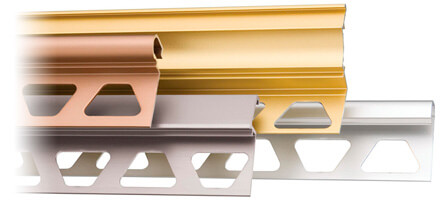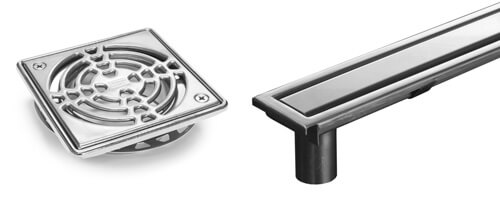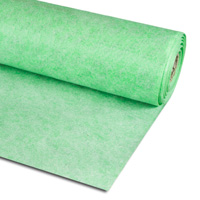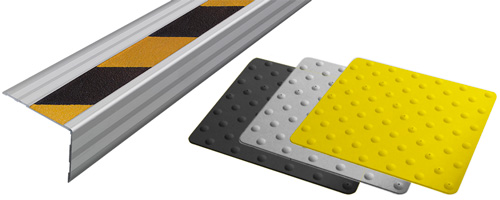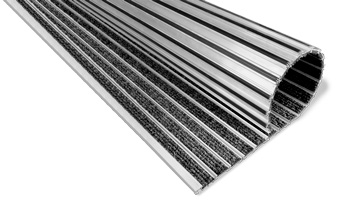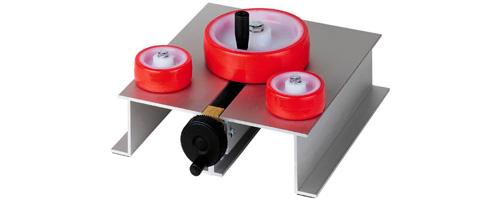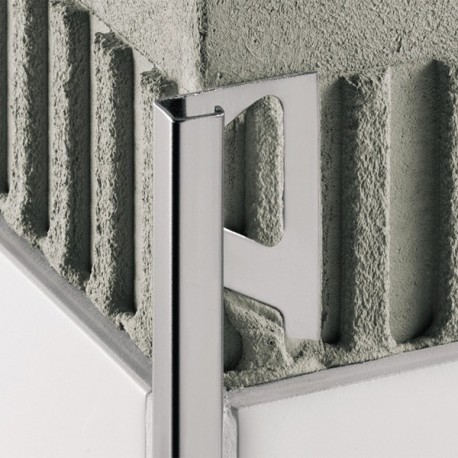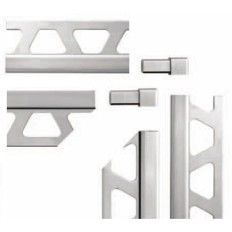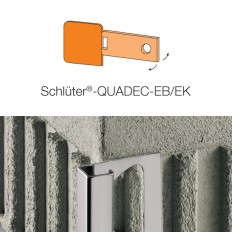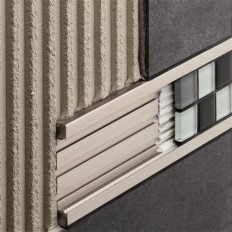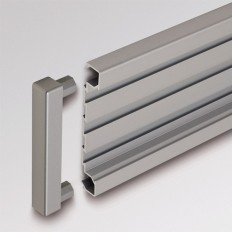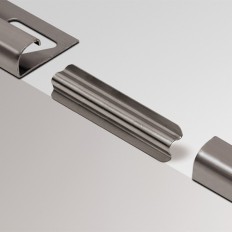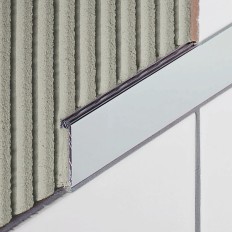QUADEC-E is a high-quality stainless steel finishing profile for exterior corners of ceramic tile-lined walls, which also offers good edge protection. The pro fi le surface forms a symmetrical square outer corner with the ceramic tiles.
QUADEC is a finishing profile for exterior corners of walls covered with ceramic tiles, which also offers good protection for the edges. The profile surface forms a symmetrical square outer corner with ceramic tiles.
QUADEC in stainless steel is especially indicated for the protection of tile edges, so it is also suitable as a finish profile on floors or as a step on stairs.
Likewise, with QUADEC you can make deliveries, corners or baseboard finishes with other coatings, such as, for example, carpet, parquet, natural stone or epoxy resin flooring. For an easy and aesthetic union of Schlüter QUADEC profiles in interior and exterior corners, there are special pieces, as well as fittings and plugs for some finishes.
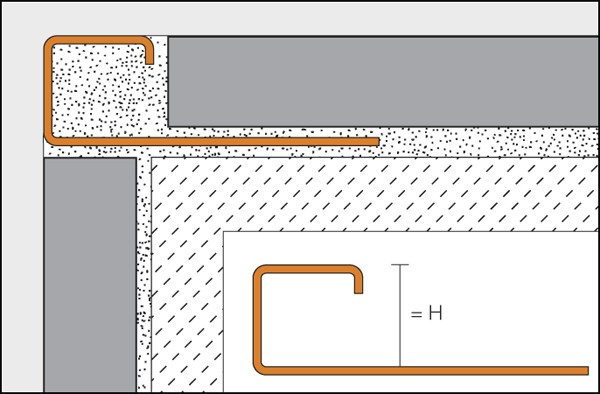
Schlüter QUADEC-E and -A can be combined with the Valance profiles Schlüter QUADEC-FS and Schlüter DESIGNLINE. In addition to the decorative effect, the profiles also protect the edges of the tiles from damage by mechanical damage. Schlüter QUADEC in stainless steel is particularly suitable for protecting the edges of tiles, making it also suitable as a finish profile on floors or as a step on stairs.
Likewise, with Schlüter QUADEC you can make deliveries, corners or baseboard finishes with other coatings, such as, for example, carpet, parquet, natural stone or epoxy resin flooring. For an easy and aesthetic connection of Schlüter QUADEC profiles in interior and exterior corners, there are special pieces, as well as fittings and plugs for some finishes.
The variable angle can be used for both interior and exterior corners.
Material
SchlüterQUADEC is available in the following finishes:
- E = Stainless steel
- EB = Brushed stainless steel
- EP = Polished stainless steel
- ES = Structured stainless steel
- EV4A = 1.4404 stainless steel (V4A)
Material properties and fields of application:
Schlüter QUADEC butt plates are manufactured in a wide variety of materials and finishes. The suitability of the type of material must be checked according to the expected chemical and / or mechanical attacks. Here are some general indications.
Schlüter QUADEC-E stainless steel butt plates are made of stainless steel of quality 1.4301-V2A (AISI 304) or 1.4404-V4A (AISI 316L) and especially indicated for areas with high mechanical and / or chemical aggressions. The fields of application are the food industry, breweries, dairies, industrial kitchens, and hospitals, but also domestic construction. For areas with special aggressions, eg in swimming pools (fresh water), we recommend the use of 1.4404-V4A stainless steel (AISI 316L). Stainless steel does not resist all chemical attacks such as hydrochloric acid, hydrofluoric acid and concentrations of salts. Special attacks must be checked before the profiles are installed.
Depending on the expected chemical attacks, you can choose between stainless steel grades 1.4301-V2A (AISI 304) or 1.4404-V4A (AISI 316L). Schlüter QUADEC-AE / -ACG / -ACGB / -AEX / -AMX / -ATX / -AQGX / -AT / -ATG / -ATGB (anodized aluminum): Due to its anodized coating, aluminum has a refined surface, which under certain circumstances normal use does not undergo changes.
Indication:
Due to different production techniques, color differences between the profiles and their angles cannot be excluded.
How to use
- Choose Schlüter QUADEC corners according to the thickness of the tiles.
- The cement-glue is applied with a notched trowel over the entire surface where the coating has to be applied. If Schlüter QUADEC is placed on the outer corner of a wall, the ceramic tiles must be laid on one wall first, and then the cementitious tile is applied on the corner of the second wall.
- The Schlüter QUADEC butt plate is placed by pressing the trapezoidal perforated side into the adhesive and adjusting the profile.
- The perforated side must be completely covered with adhesive and the open chamber of the profile must be filled with cement-glue.
- The tiles are placed by pressing them and adjusting them to the profile level. There should be no gaps in the back of the tiles in the profile areas.
- The tiles are placed next to the profile spacer, thus guaranteeing the existence of a uniform 1.5 mm joint. In the case of stainless steel profiles, a joint of approx. 1.5 mm. The joints between the profile and the tiles must be completely filled with grouting mortar.
- Sensitive finishes must be treated with materials and tools, which cannot cause deterioration and scratches. Any remaining grouting mortar or cement-glue must be removed immediately.
- Special parts are supplied for the outer corners.
Maintenance
Schlüter QUADEC does not require any special maintenance. For sensitive finishes, no abrasive cleaning product should be used.
The oxide layer on brass or aluminum surfaces can be removed by standard polishing products, although it will form again over time. Deterioration of the anodized layers can only be removed by repainting.
Stainless steel profiles obtain a shiny surface using chrome polishing products or the like. Stainless steel finishes exposed to the weather or aggressive substances should be cleaned regularly using non-aggressive cleaning products. Regular cleaning not only maintains the clean appearance of stainless steel but also reduces the risk of corrosion. In no case can cleaning products contain hydrochloric acid or hydrofluoric acid.
Contact with other metals, such as normal steel, should be avoided, as this can lead to contamination with foreign oxide. The same applies to tools such as trowels or steel wool, which are used for the removal of mortar remains. If necessary, Schlüter CLEAN-CP cleaning polish is available.
What is stainless steel?
"Stainless steel" is the collective concept for a group of more than 160 types of stainless steel with different compositions respectively.
This description is based on the creation of a chromium oxide layer on the surface of the stainless steel with a thickness of approx. one thousandth of mm. It is a very thin layer with the capacity to renew itself in case of deterioration, so that, as a general rule, no rust can appear in this type of steel.
The condition for fulfilling this characteristic is that the protective layer is not damaged for a long time (eg, by contamination with other oxides or certain chemical products, such as hydrochloric acid). These deteriorations can occur especially in areas with chemical attacks, such as e.g. For example, in outdoor areas near the sea or in regions with a high level of industrial air pollution, as well as in the food industry or swimming pools. In these cases we recommend the use of V4A stainless steel grade (material number 1.4404 = AISI 316 L), instead of the conventional V2A grade (material number 1.4301 = AISI 304), which has a higher resistance to oxidation , meeting the highest demands.
The official designation for material nº 1.4301 according to DIN EN 10088 is X5CrNi18-10. The designation for material No. 1.4404 according to DIN EN 10088 is X2CrNiMo17-12-2.

